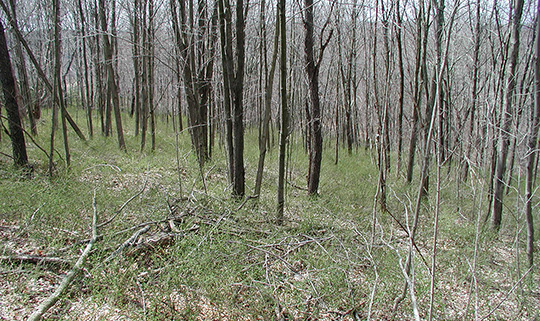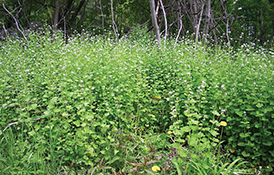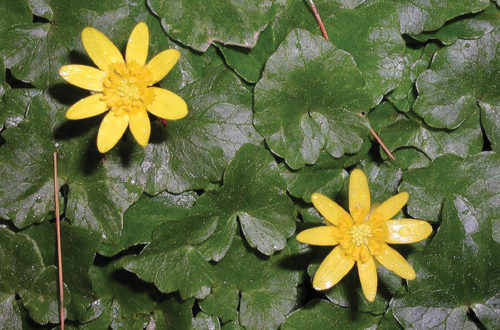To help those of who are seeking more answers about why barberry is considered invasive and a tick nursery — here’s a pdf and text of the editorial Will did back in 2015 (pre-digital CG).
We hope it helps! It’s a very big subject, when you get down to it, and in our opinion, the more aware people are of their landscapes and the plants in them and their relation to the ecosystem, the better we are able to choose plants that are beneficial and non-invasive.
And, as you will read, it’s wise to be aware of the environments where tickborne diseases can hide, and eliminate them if they exist in your patch of land. Your barberry at the front door is not the tick nursery we are speaking of, but rather the infestations that result from its berries (and the berries of all barberries in all landscapes) eaten by birds, pooped out and germinated on a patch of open ground. The photo at top may look familiar.
Time to Get Real About Our Tick Nurseries
From Connecticut Gardener July/August 2015
A number of media sources are reporting a new, potentially deadly, virus in Connecticut that’s transmitted by deer tick bites. Actually, it’s not new. We’ve known about the presence of Powassan virus (POWV) in Connecticut for years.
In a survey conducted by The Connecticut Agricultural Experiment Station (CAES) from 2008-2012 in Bridgeport and North Branford, 0.4 to 3.9% of the ticks tested were infected with the virus.
To put things into perspective, Dr. Philip Armstrong at CAES says 20-50% of ticks carry the Lyme disease agent.
POWV was first identified in 1958 in Powassan, Ontario. It’s a RNA virus of the genus Flavivirus and is related to West Nile virus and other tickborne diseases.
Human cases are extremely rare and none have been confirmed in Connecticut. According to the Centers for Disease Control and Prevention (CDC) approximately 50 cases in humans have been documented in the U.S. over the past 10 years. There have been cases in Dutchess County, NY, and New Jersey so it’s probably just a matter of time until we see one in Connecticut.
The primary human-biting tick is Ixodes scapularis, the same tick that transmits Borrelia burgdorferi (the causal agent of Lyme disease) and the agents of several other tickborne diseases.
It’s noteworthy that POWV is maintained in an enzootic or sylvatic cycle by deer ticks and their hosts, whitetailed deer and mice … the same cast of vectors and hosts that are associated with Lyme disease.
As a reminder, research by Dr. Scott Williams and Dr. Jeff Ward at CAES revealed that forests with incursions of Japanese barberry (Berberis thunbergii) are prime breeding grounds for deer ticks and are 12 times more likely to harbor the deer ticks that carry the Lyme disease agent.
Dr. Williams confirmed my suspicion that barberry incursions harbor the Powassan virus in addition to Lyme disease.
Unfortunately, Japanese barberry has never been banned in Connecticut. Banning it now might be a nice gesture but the horse has left the barn.
The Connecticut Invasive Plant Council (IPC), the group charged with overseeing invasive plants in Connecticut and making recommendations to lawmakers, considered the issue but chose not to recommend a ban on Japanese barberry. Presumably because it’s a popular plant and some cultivars are less aggressive/invasive than others.
The Connecticut Nursery & Landscape Association has voluntarily phased out the more aggressive cultivars, and we commend them for doing so, but more needs to be done.
Barberry incursions were a public health hazard even before CAES discovered POWV in Connecticut. Perhaps the presence of a potentially fatal virus lurking in the same environment will spur us on. Eradication is a process that will take time, resources and the cooperation of many different stakeholders.
Unfortunately, the average homeowner doesn’t get it. They think the plant is pretty and don’t see it spreading in their yard. According to the National Resources Conservation Service, “Japanese barberry forms dense stands in natural habitats including woodlands, wetlands, and pastures, and alters soil pH, nitrogen levels, and biological activity in the soil. Reproduction is primarily through prolific seeds (high germination rate) although there are also reports of sprouting from roots as well as vegetative layering. Seeds are spread by birds and mammals.”
Be Careful Out There
Most at risk are people who spend a lot of time outdoors, and that includes us gardeners. POWV is potentially fatal and there is no cure, only supportive treatment.
To make matters worse, according to some sources, you can be infected by a tick bite in less than an hour. That’s much faster than Lyme disease, which can take a day or two, depending on the size of the tick. Obviously, it’s more
important than ever to check yourself.
CDC advises that “You can reduce your risk of being infected with POW virus by using tick repellents, wearing long sleeves and pants, avoiding bushy and wooded areas, and doing thorough tick checks after spending time outdoors.”
Symptoms
Symptoms may be mild or even absent. It can, however, cause serious illness. According the CDC, “Healthcare providers should watch for symptoms that include fever, headache, vomiting, confusion, seizures, memory loss and generalized weakness. POWV can infect the central nervous system and cause meningitis and encephalitis. Powassan encephalitis has a 10% case-fatality rate, and up to 50% of survivors will experience long-term neurological symptoms that may include stiff neck, altered mental status, seizures, aphasia, paresis, movement disorders, or cranial nerve palsies. The incubation period is generally 7-14 days; however, it can be up to one month after a tick bite.”
For more information, go to www.cdc.gov/powassan
What are we waiting for? The writing is on the wall
– Will Rowlands





